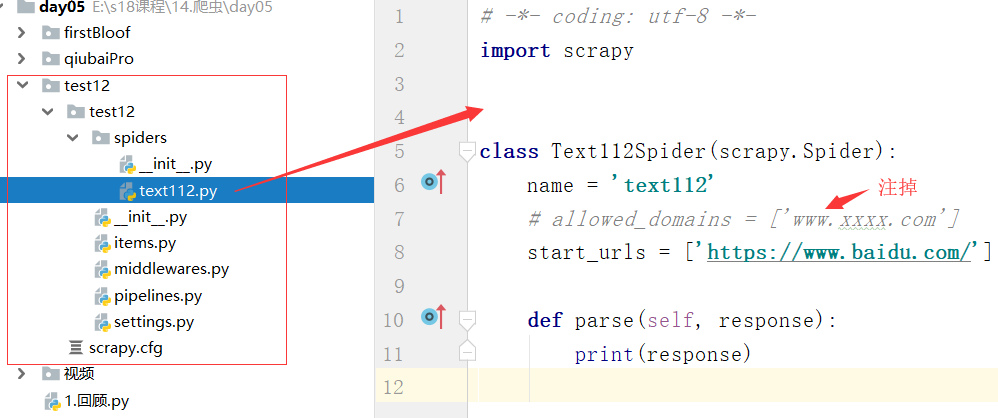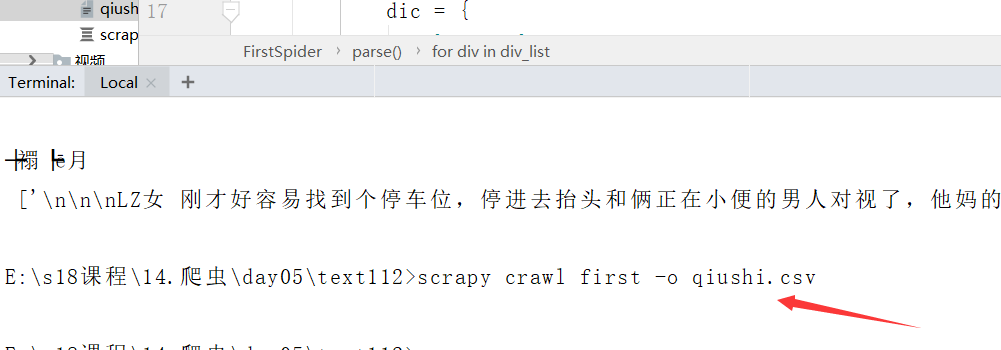爬虫 --- 06. scrapy框架初始,移动端数据爬取
一.基本概念
- scrapy:爬虫框架。
异步爬取,高性能的数据解析+持久化存储操作,
集成了各种功能(高性能异步下载,队列,分布式,解析,持久化等)的具有很强通用性的项目模板。
- 框架:集成了很多功能且具有很强通用性的一个项目模板
- 如何学习框架: - 学习框架的功能模块的具体使用。
二. 环境的安装
windows系统:
a. pip3 install wheel b. 下载twisted http://www.lfd.uci.edu/~gohlke/pythonlibs/#twisted c. 进入下载目录,执行 pip3 install Twisted‑17.1.0‑cp35‑cp35m‑win_amd64.whl d. pip3 install pywin32 e. pip3 install scrapy
Linux系统:
pip3 install scrapy
三. 使用流程
- ① 创建一个工程:scrapy startproject firstBlood
- ② cd firstBlood
- ③ 创建爬虫文件:scrapy genspider first www.xxx.com
- ④ 执行:scrapy crawl first
scrapy crawl 爬虫名称 :该种执行形式会显示执行的日志信息
scrapy crawl 爬虫名称 --nolog:该种执行形式不会显示执行的日志信息
项目结构:
project_name/ scrapy.cfg: project_name/ __init__.py items.py pipelines.py settings.py spiders/ __init__.py scrapy.cfg 项目的主配置信息。(真正爬虫相关的配置信息在settings.py文件中) items.py 设置数据存储模板,用于结构化数据,如:Django的Model pipelines 数据持久化处理 settings.py 配置文件,如:递归的层数、并发数,延迟下载等 spiders 爬虫目录,如:创建文件,编写爬虫解析规则
四.基本结构:
# -*- coding: utf-8 -*- import scrapy class QiubaiSpider(scrapy.Spider): name = 'qiubai' #应用名称 #允许爬取的域名(如果遇到非该域名的url则爬取不到数据) allowed_domains = ['https://www.qiushibaike.com/'] #起始爬取的url start_urls = ['https://www.qiushibaike.com/'] #访问起始URL并获取结果后的回调函数,该函数的response参数就是向起始的url发送请求后,获取的响应对象.该函数返回值必须为可迭代对象或者NUll def parse(self, response): print(response.text) #获取字符串类型的响应内容 print(response.body)#获取字节类型的相应内容
爬虫文件



示例:
#嗅事百科 作者和内容
# -*- coding: utf-8 -*- import scrapy class FirstSpider(scrapy.Spider): name = 'first' # allowed_domains = ['www.xxx.com'] start_urls = ['https://www.qiushibaike.com/text/'] def parse(self, response): div_list = response.xpath('//div[@id="content-left"]/div') for div in div_list: autor = div.xpath('./div[1]/a[2]/h2/text()').extract_first() content = div.xpath('./a/div/span//text()').extract() print(autor,content)
五.持久化存储
- 持久化存储: - 基于终端指令:scrapy crawl qiubai -o filePath.csv - 好处:便捷 - 弊端:局限性强(只可以将数据写入本地文件,文件后缀是由具体要求) - 基于管道: - 基于持久化存储的所有操作都必须写入到管道文件的管道类中
- 数据持久化存储 - 基于终端指令: - 只可以将parse方法的返回值进行持久化存储 - scrapy crawl SpiderName -o ./file
- 基于管道持久化存储的编码流程: - 数据解析 - 在item类中声明相关的属性用于存储解析到的数据 - 将解析到的数据存储封装到item类型的对象中 - 将item对象提交给管道类 - item会被管道类中的process_item方法中的item参数进行接收 - process_item方法中编写基于item持久化存储的操作 - 在配置文件中开启管道
- 管道细节处理: - 管道文件中一个类对应的是什么? - 一个类表示的是将解析到的数据存储到某一个具体的平台中 - process_item方法中的返回值表示什么含义? - return item就是说将item传递给下一个即将被执行的管道类 - open_spider,close_spider
1.基于终端指令存储
必须以结构 [{},{}] 的形式
执行输出指定格式进行存储:将爬取到的数据写入不同格式的文件中进行存储 scrapy crawl 爬虫名称 -o xxx.json scrapy crawl 爬虫名称 -o xxx.xml scrapy crawl 爬虫名称 -o xxx.csv
#示例:
# -*- coding: utf-8 -*- import scrapy class FirstSpider(scrapy.Spider): name = 'first' # allowed_domains = ['www.xxx.com'] start_urls = ['https://www.qiushibaike.com/text/'] def parse(self, response): all_data = [] div_list = response.xpath('//div[@id="content-left"]/div') for div in div_list: autor = div.xpath('./div[1]/a[2]/h2/text()').extract_first() content = div.xpath('./a/div/span//text()').extract() # print(autor,content) dic = { 'author':autor, 'content':content, '---':"\n"+"----------------------------------------" } all_data.append(dic) return all_data

2.基于管道的持久化存储

#在爬虫文件中
# -*- coding: utf-8 -*- import scrapy from qiubaiPro.items import QiubaiproItem class QiubaiSpider(scrapy.Spider): name = 'qiubai' # allowed_domains = ['www.xxx.com'] start_urls = ['https://www.qiushibaike.com/text/'] def parse(self, response): div_list = response.xpath('//div[@id="content-left"]/div') all_data = [] for div in div_list: # author = div.xpath('./div[1]/a[2]/h2/text()')[0].extract() author = div.xpath('./div[1]/a[2]/h2/text()').extract_first() content = div.xpath('./a/div/span//text()').extract() content = ''.join(content) # print(content) #实例化一个item类型的对象 item = QiubaiproItem() #使用中括号的形式访问item对象中的属性 item['author'] = author item['content'] = content #将item提交给管道 yield item
#items.py文件中
import scrapy class QiubaiproItem(scrapy.Item): # define the fields for your item here like: # name = scrapy.Field() #scrapy.Field()万能的数据类型 author = scrapy.Field() content = scrapy.Field()
#pipelines.py(管道文件)中
# -*- coding: utf-8 -*- # Define your item pipelines here # # Don't forget to add your pipeline to the ITEM_PIPELINES setting # See: https://doc.scrapy.org/en/latest/topics/item-pipeline.html #一个类表示的是将解析/爬取到的数据存储到一个平台 import pymysql from redis import Redis
#存在本地文件 class QiubaiproPipeline(object): fp = None def open_spider(self,spider): print('开始爬虫......') self.fp = open('./qiubai.txt','w',encoding='utf-8') #可以将item类型的对象中存储的数据进行持久化存储 def process_item(self, item, spider): author = item['author'] print(author, type(author)) content = item['content'] self.fp.write(author+ ":"+content) return item #返回给了下一个即将被执行的管道类 def close_spider(self,spider): print('结束爬虫!!!') self.fp.close()
# 存在mysql数据库中 class MysqlPipeLine(object): conn = None cursor = None def open_spider(self,spider): self.conn = pymysql.Connect(host='127.0.0.1',port=3306,user='root',password='',db='qiubai',charset='utf8') print(self.conn) def process_item(self, item, spider): self.cursor = self.conn.cursor() try: self.cursor.execute('insert into qiubai values("%s","%s")'%(item['author'],item['content'])) self.conn.commit() except Exception as e: print(e) self.conn.rollback() return item def close_spider(self,spider): self.cursor.close() self.conn.close() #存在redis数据库 class RedisPipeLine(object): conn = None def open_spider(self,spider): self.conn = Redis(host='127.0.0.1',port=6379) print(self.conn) def process_item(self,item,spider): dic = { 'author':item['author'], 'content':item['content'] } self.conn.lpush('qiubai',dic)
setting配置文件中

六.移动端数据的爬取
- 移动端数据爬取: - 抓包工具: - fiddler,mitproxy - 在手机中安装证书: - 让电脑开启一个wifi,然后手机连接wifi(手机和电脑是在同一个网段下) - 手机浏览器中:ip:8888,点击超链进行证书下载 - 需要将手机的代理开启:将代理ip和端口号设置成fiddler的端口和fidd所在机器的ip
详细操作查看视频


